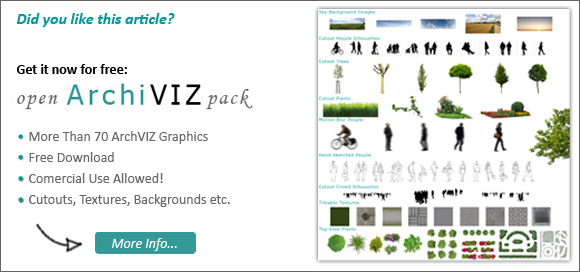![3D Architectural Renderings with Photoshop [by vizoom]](https://www.tonytextures.com/wp-content/uploads/2013/11/3D-Architectural-Renderings-In-Photoshop.jpg)
Generally there is no strict rule of separating the tasks correctly. It depends especially from the intention and the context of the job. If you want to use your 3d model also for creating an animated architectural walkthrough and present the video to your customer it makes more sense to put more effort in the 3d model. On the other hand there will always be projects you are forced to conduct the quick-and-dirty way where you can better add some visual effects to the architectural rendering in Photoshop.
From my point of view it typically makes sense to create the general lightning and first texturing jobs in 3ds MAX or Cinema4D (or the 3d tool you use) when you will only need one or two architectural renderings of your scenery. Usually we also add some rough surrounding geometry just to make sure that in the post production the perspective look is correct.
But there is a ton of options you have in Photoshop afterwards to create shiny objects or add cutout trees, people and cars. In addition we recommend rendering the 3d scenery in a few separated layer. For instance you can create one rendering with a very bright sun effect and strong shadows. In another rendering you put more emphasis to the general global illumination and smooth shadows. Afterwards you can import each rendering in Photoshop as a separate layer and combine both by changing the transparency of the layer.
I stumbled upon two interesting videos created by vizoom, a german company specialized on architectural visualizations. In the video they started with the original output rendering of their 3d software and add second by second all additional layer which were added in Photoshop. It is an interesting trip from start to finish of a visualization job to get a feeling about the power of pimping the rendering in Photoshop to a photorealistic look. Take a look:
180 layers from Vizoom on Vimeo.
140layers from Vizoom on Vimeo.
What is your preferred way to use Photoshop in your 3d architectural renderings?

Leave a Reply